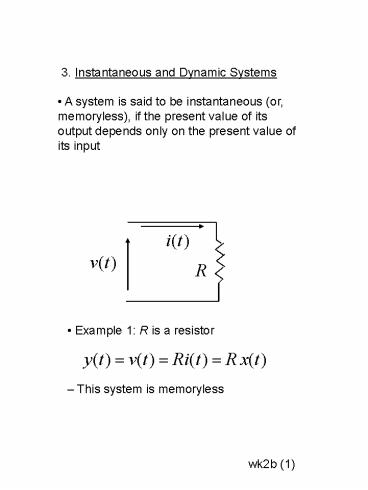3' Instantaneous and Dynamic Systems PowerPoint PPT Presentation
Title: 3' Instantaneous and Dynamic Systems
1
- 3. Instantaneous and Dynamic Systems
- A system is said to be instantaneous (or,
memoryless), if the present value of its output
depends only on the present value of its input
- Example 1 R is a resistor
- This system is memoryless
2
- Example 2 C is a capacitor
- This system is with memory, because
- A linear time-variant memoryless system
- A linear time-invariant memoryless system
3
- 4. Other Classifications
- Causal and Non-causal Systems
- Lumped and distributed parameter systems
- Discrete-time systems
4
- Chapter 2
- Time-Domain Analysis of LTIC Systems
- LTIC means Linear, Time-Invariant,
Continuous-Time - 2-1 Response of a Linear System
- Consider SISO (single-input, single-output)
cases - A systems output for depends on two
causes - (1) Initial conditions at
- (2) Input for
- i.e. There are two parts in the output (a)
zero-input response (b) zero-state response
5
- Example 1 RC circuit (Fig. 1.26)
6
- Zero-Input (Z-I) response
- Result of internal system conditions
- Zero-State (Z-S) response
- Result of external input
- The Z-I and Z-S responses are independent each
other - Example 2 (RLC circuit, p. 80 and p. 111 of
textbook)
7
- Example
- The characteristic polynomial, equation, roots,
and modes
8
- Caveat !
- The output can also be expressed in another way
- Total output natural response forced response
- This concept is different than Z-I and Z-S
concepts - You should have known this in the Circuit
course(s) - Read Example 2.2 in p. 111 to refresh your
memory and enhance your understanding
PowerShow.com is a leading presentation sharing website. It has millions of presentations already uploaded and available with 1,000s more being uploaded by its users every day. Whatever your area of interest, here you’ll be able to find and view presentations you’ll love and possibly download. And, best of all, it is completely free and easy to use.
You might even have a presentation you’d like to share with others. If so, just upload it to PowerShow.com. We’ll convert it to an HTML5 slideshow that includes all the media types you’ve already added: audio, video, music, pictures, animations and transition effects. Then you can share it with your target audience as well as PowerShow.com’s millions of monthly visitors. And, again, it’s all free.
About the Developers
PowerShow.com is brought to you by CrystalGraphics, the award-winning developer and market-leading publisher of rich-media enhancement products for presentations. Our product offerings include millions of PowerPoint templates, diagrams, animated 3D characters and more.

